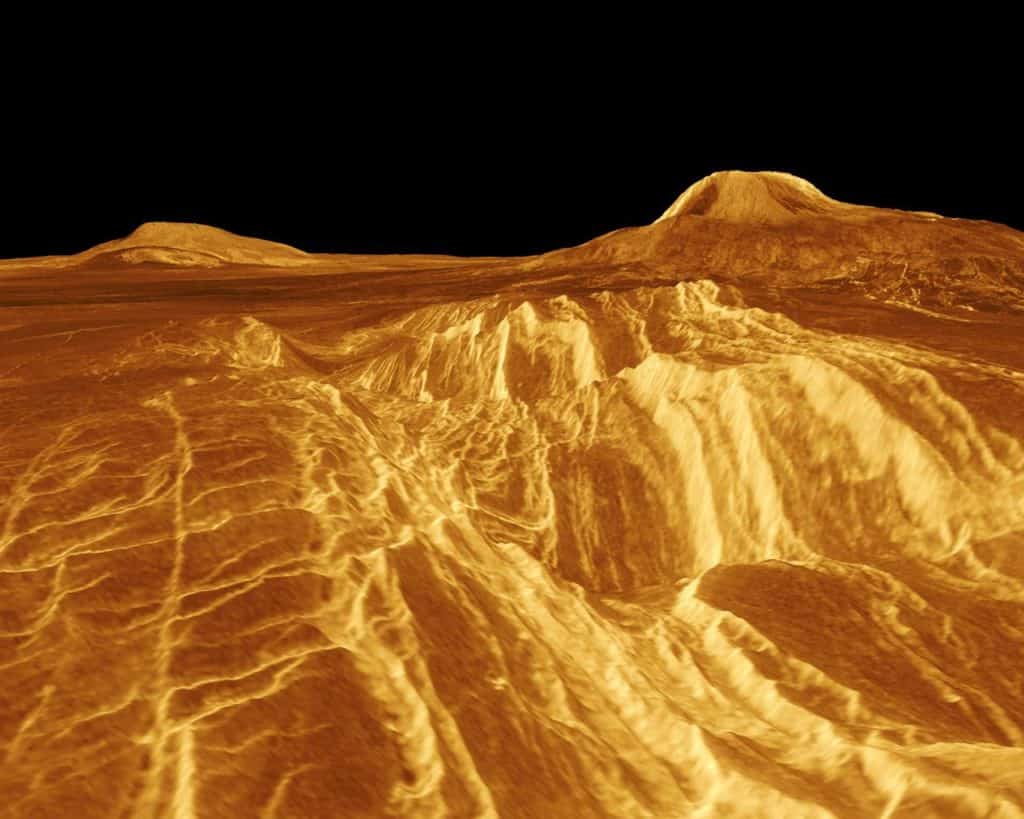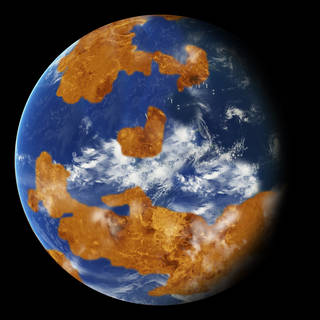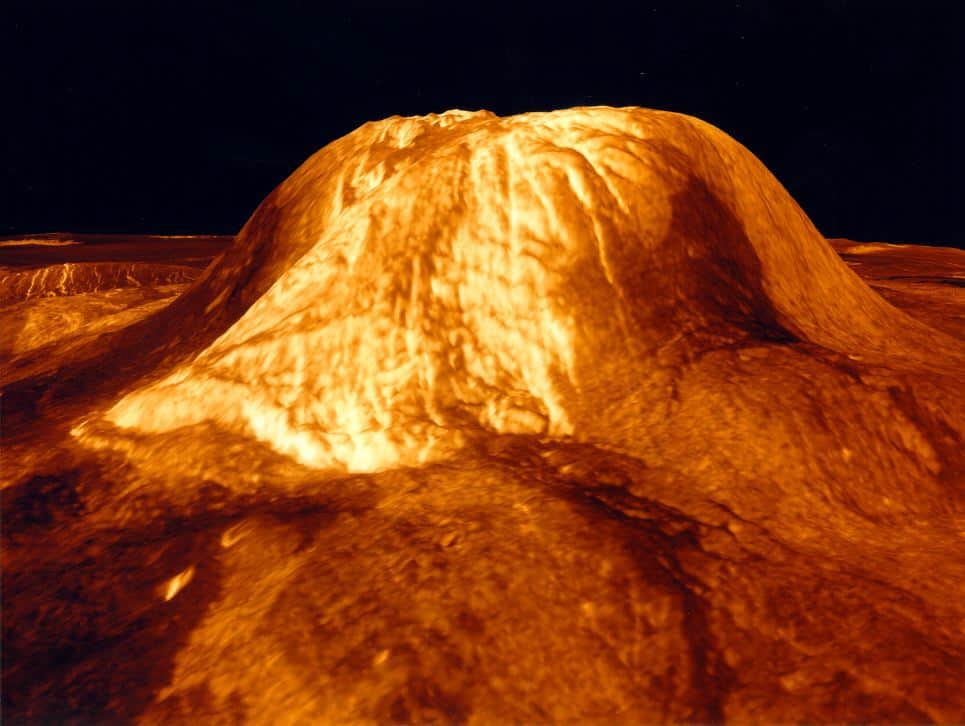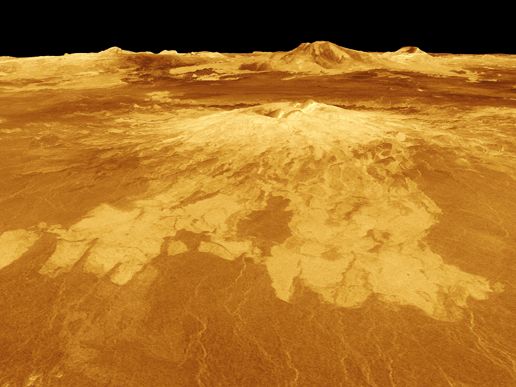The planet Venus is named after the ancient Roman goddess of love and beauty. In Greek mythology, she is known as Aphrodite. The planet was named after this goddess because, for the ancient people, it shinned the brightest.
Key Facts & Summary
- Venus is the second planet from the Sun, and the sixth-largest planet in the Solar System.
- Venus and Mercury are the only planets in the Solar System that do not have a moon.
- Venus is the second brightest object in the sky after the Moon, and the Sun.
- It is the only planet named after a female deity and the brightest planet in the Solar System.
- Venus is 62 degrees hotter than Mercury, the closest planet to the Sun.
- Venus has a radius of 6.051 kilometers / 3.760 miles, and a diameter of 12.104 km / 7.521 mi. It is only slightly smaller than Earth.
- Venus is at a distance of 108 million km / 68 million mi away from the Sun.
- One day on Venus lasts for about 243 Earth days. This is the slowest rotation of any planet making it the most spherical object in the Solar System, after the Sun.
- Venus and Uranus rotate in the opposite direction than the other planets. They both move from East to West, clockwise.
- Venus has montains, valleys, and tens of thousands of volcanoes. The highest mountain on Venus, Maxwell Montes, is 20,000 feet / 8.8 kilometers high – very similar to the highest mountain on Earth, Everest.
- Apart from lacking any moons, Venus also doesn’t have a ring system, and because it rotates very slowly, its magnetosphere is also very weak.
- The average temperatures on Venus have been estimated to be at around 465 degrees Celsius / 900 degrees Fahrenheit, this is hot enough to melt lead.
- Venus is very similar to Earth, and because of this, it is referred to as Earth’s sister.
In our Solar System, the planet closest to the Sun is Mercury. But even though it is the nearest, it isn’t the hottest planet. Venus is actually the hottest planet out of all the planets in the Solar System.

But how can this be? Well, Venus has gases and clouds of sulfuric acid that traps the heat and keeps Venus toasty warm. It is so hot on Venus, that even metals would melt and become liquid.
Surface and Structure
Venus is a little smaller than Earth, but like our planet, it has mountains, volcanoes, and few craters that indicate a relatively young surface. Both worlds also have similar densities and chemical compositions.

Venus is sometimes referred to as Earth’s sister since scientists believe that it once had large amounts of water; however, it boiled away due to high temperatures.
This might have also happened to our planet if it was closer to the Sun. Venus is quite special since it spins in the opposite direction of most other planets, including Earth.
Most of Venus’s surface consists of gently rolling plains. Mountains and hills are rare. Much of the surface is covered by lava flows. In fact, there are plenty of large volcanoes like the ones in Hawaii on Venus.
One of the largest volcanoes on Venus is Sif Mons. The interesting fact is that Venus has many active volcanoes on its surface to this day.

Time on Venus
Venus’s rotation is also very slow. One day on Venus is equal to 243 Earth days, and one year or one trip around the Sun takes 225 Earth days. This means that a day is longer than a year on Venus.
On Venus, the Sun rises once every 117 Earth days, this means that the Sun rises twice each Venusian year. On Earth, the Sun rises and sets once each day.
Since Venus rotates backwards, the Sun rises in the west and sets in the east.
Fun Facts:
- The symbol for Venus is actually the world symbol for the female gender.
- Though Venus can be easily seen, its surface is hidden by thick clouds and because of this, it was believed for a long time that the planet was similar to Earth.
- The big surprise came when with the advancement of technology, we managed to pierce through Venus’s clouds and observe its surface, and it doesn’t look like Earth at all.
- Venus reflects 70% of all the sunlight it receives and this is the reason for why it shines so bright.
- Because of its brightness, Venus has been the most confused object in the sky. Many have misreported it as an UFO, and many still do so to this day.
- Venus is among the most visited planets in the Solar System. More than 40 spacecraft have explored it.
- In ancient times, Venus was thought of as two different objects in the sky: The Mourning Star, and the Evening Star. The same confusion happened with the planet Mercury.
- The first accurate observations of Venus were conducted by Galileo Galilei in 1610.
- It takes sunlight 6 minutes to reach Venus. If you were on Venus and the Sun suddenly disappeared, you would only notice it after 6 minutes.
- Earth orbits around the Sun 8 times for every 13 orbits of Venus.
Size and Comparison
Venus has a radius of 6.051 kilometers / 3.760 miles and a diameter of 12.104 km / 7.521 mi. It is only slightly smaller than Earth. It is the sixth-largest planet in the Solar System and the second-largest terrestrial planet.

In comparison to Mars, Venus is two times bigger. Jupiter, the largest planet in the Solar System, has more than 11 times the diameter of Venus. On the other end, Mercury, the smallest planet in the Solar System, is three times smaller than Venus.
Trivia
Earth’s Sister
Venus is Earth’s sister since it has a similar size, density, a similar internal structure, mass, volume, and atmospheric components of carbon dioxide and nitrogen.

Many believe that Venus was even more similar to Earth billions of years ago, having even oceans, but something happened and changed all of this.
The Morning and Evening Star
The Venus tablet of Ammisaduqa, believed to have been compiled around the mid-17th century BCE, shows that the Babylonians understood that the Evening Star and Morning Star were a single object.
Venus was referred to in the tablet as the “bright queen of the sky”, and they could support this view with detailed observations. The Chinese people referred to the mourning Venus as The Great White or Opener of Brightness, and they reffered to the evening Venus as the Excellent West One.
Other characteristics
Venus and Mercury are the only terrestrial planets in the Solar System that don’t have moons. The planets closest to Venus, its neighbors, are Earth and Mercury.

Venus is almost always visible with the naked eye. You don’t need binoculars or telescopes to see it. In ancient times, the planet was also called the “morning star” or the “evening star” since it is very bright.
Some of the craters on Venus look like big spiders, and because of this, they have been named “Arachnoids.” Some of the Volcanoes appear to be so squashed from above, they have been named “pancake volcanoes.”

Venus Notes
- Venus is the sixth-largest planet in the Solar System, but it is the second-largest out of the terrestrial planets.
- The clouds on Venus are yellowish since they aren’t made of water like the ones on Earth. Instead, they are formed from a poison called sulfuric acid.
- Venus is very hot – about 400 degrees Celsius. Temperatures don’t change even when at night.
- Though Venus has many clouds, it is too hot to rain.
- Venus has been visited by more than 40 spacecraft. The first was Mariner 2 in 1962. Some of these spacecraft include Mariner 5, Mariner 10, Pioneer Venus 1, Pioneer Venus 2, and an orbiter called Magellan.
- Venus doesn’t have a moon.
- The Americans were the first to land on the Moon, but the Russian’s sent the first spacecraft to Venus.
- Any spacecraft sent to Venus survives for around an hour because of the hot temperatures.
Sources:
[1.] Wikipedia
[2.] NASA
Image sources:
- https://www.nasa.gov/sites/default/files/thumbnails/image/venus20191211-16.jpg
- https://spaceplace.nasa.gov/review/all-about-venus/Venus_Clouds_br.en.jpg
- https://cdn.mos.cms.futurecdn.net/rCdTVsPesASiv3JeVyhHsa-1200-80.jpg
- https://www.nasa.gov/sites/default/files/styles/side_image/public/thumbnails/image/ancient-venus-new.jpg?itok=4jxFznMD
- https://www.jpl.nasa.gov/spaceimages/images/largesize/PIA00200_hires.jpg
- https://nssdc.gsfc.nasa.gov/image/planetary/venus/mgn_gula_mons.jpg
- https://i.pinimg.com/originals/1b/b9/93/1bb993af79702473fe6219694c9b0e60.jpg
